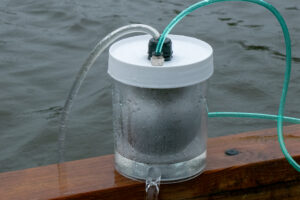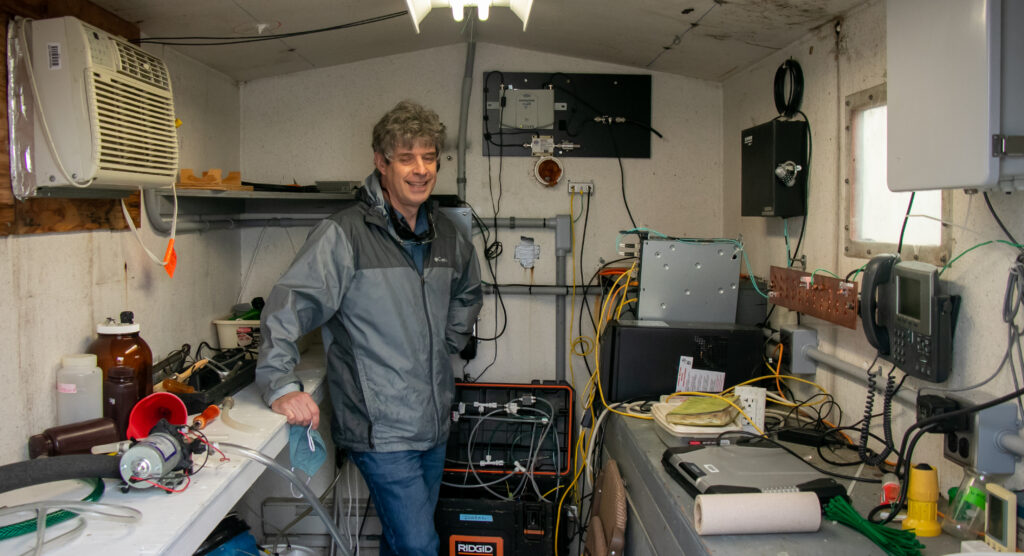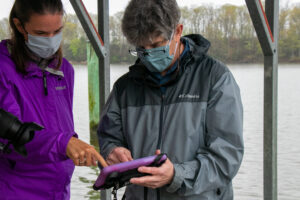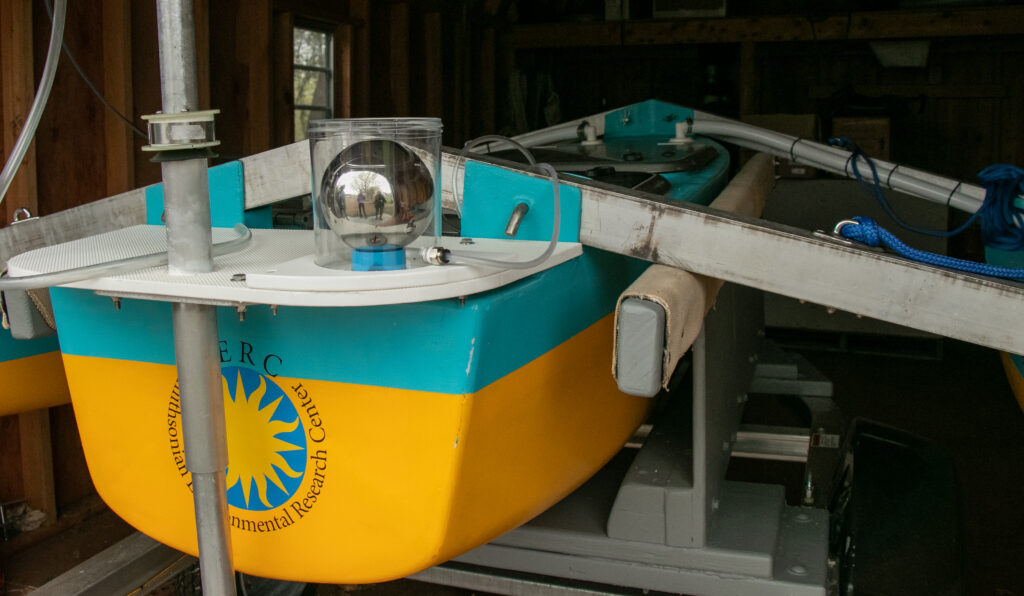by Marisa Sloan, Northwestern University

The silver EQSphere measures dissolved carbon dioxide and methane, potent greenhouse gases, in the Rhode River on a rainy afternoon. (Photo: Marisa Sloan/Northwestern University)
Don’t be fooled—the EQSphere™ isn’t a silver softball or a tree ornament gone rogue. It’s a spherical equilibrator invented to continuously yank carbon dioxide, methane and other gases from three feet underwater into the air to be measured in real time.
Whitman Miller, a research scientist with the Smithsonian Environmental Research Center, came up with the design with his head technician Amanda Reynolds while they were studying the effects of elevated carbon dioxide in marine ecosystems. He considers it an invention born of necessity, thanks to turbid and debris-ridden coastal waters, where it’s dangerous to deploy expensive instruments for very long.
“We tried a variety of existing air-water equilibrator designs with varying degrees of success,” he said. “They can be a bit fiddly and sometimes freeze or clog, leading to flooding events that can ruin measurements and electronics.”
Fouling is another issue, one tea drinkers may be familiar with if they’ve noticed mineral deposits accumulating within their kettles. The EQSphere avoids these problems by pumping about 70 gallons of free-flowing water over its spherical surface every hour. When connected to power and a portable gas analyzer, it can churn out real-time measurements for weeks or months at a time without maintenance.
Oceans, estuaries and rivers soak up a large fraction of the carbon dioxide and other greenhouse gases from fossil fuels. In doing so, these habitats help mitigate climate change. Monitoring the rise and fall of this “blue carbon” may reveal new insights into the players that drive it: photosynthesis, underwater organisms, changing tides and even the weather.
Falling Films

Whitman Miller measures the concentrations of gases in the Rhode River and atmosphere from this small shed at SERC’s dock. His invention, the EQSphere, allows him to make similar measurements in more remote locations. (Photo: Marisa Sloan/Northwestern University)
Although invented to preserve some pretty expensive research instruments, the EQSphere itself doesn’t require a ton of fancy technology.
“A major part of my design process includes stalking the aisles of hardware and kitchenware stores,” Miller said. “Plumbing supply sections are especially useful!”
The equilibrator’s design takes advantage of a powerful phenomenon scientists have used since the early 20th century: the falling film. When a pump pours water over its sphere, a super thin film—about half as thick as a credit card and nearly impossible to notice with the bare eye—sticks to its surface all the way down before exiting through an airtight drain at the bottom. The scientists then cycle a small amount of upward-moving air to trigger a measurable gas exchange with the water.

Genevieve Noyce (left) and Whitman Miller (right) follow the equilibrator’s real-time measurements from a tablet. (Photo: Marisa Sloan/Northwestern University)
The air consists of a mixture of gases whose concentrations the scientists already know. If the water’s carbon dioxide concentration is higher than the recirculating air’s, molecules jump out of the water to balance things out. Likewise, if the water’s concentration is lower than the air’s, the gas molecules move from air to water.
Although commonly used to facilitate heat transfer and evaporation in industrial chemical plants, Miller said falling films can be found everywhere from rocky river rapids to the bowls and spoons in your kitchen sink. Just add water!
“In the case of the EQSphere, we use an engineering trick,” Miller said. “A large volume of water is continuously renewed, and a small volume of air is recirculated between the equilibrator and gas analyzer, and back again, in a closed loop. By doing this, the air will take on the concentration of the water every time.”
Navigating New Waters
Miller and his colleagues have used his invention to measure dissolved carbon dioxide for several years. But recent success connecting it to a gas analyzer that measured methane—an even more powerful greenhouse gas—hinted at more possibilities.
One spring day in 2021, dissolved carbon dioxide at SERC’s dock dipped below 10 parts per million, likely due to photosynthesis and cold waters that suppressed respiration by organisms. That’s a mere 2.4% of current atmospheric carbon dioxide levels. Yet dissolved methane skyrocketed upward to about 30 times the concentration in the atmosphere, likely due to biogeochemical processes from bottom-dwelling plants and animals and the water column.
“Seeing these two trace gases diverge in opposite directions provides more evidence that the EQSphere is behaving as expected, so reinforces our confidence in its effectiveness with other trace gases,” Miller said.
When paired with portable sensors, he expects the device to work for measuring trace gases important in environmental and industrial monitoring. For example, drinking water treatment plants could more easily detect trihalomethanes and other disinfection byproducts. Similarly, it could analyze landfill leachate and runoff from mines or agriculture—which can pollute the water supply—even in far off locations.

The EQSphere, a spherical equilibrator invented to help measure trace gases in water, sits on the autonomous research vessel “SMART-e. (Photo: Marisa Sloan/Northwestern University)
Because the EQSphere is compact and its spherical design functions well even under extreme tipping, it’s also ideal for boats, buoys and other unstable field installations. For Miller, it’s a unique opportunity to pair his newest invention with one from the past: an 8-foot-long, zero-emissions research vessel dubbed “SMART-e.” (It stands for “Smithsonian Marine Autonomous Research Trimaran-electric.”) Designed in collaboration with the United States Naval Academy’s Paul Miller and Austin Tortorici, the autonomous vessel’s three hulls glide through shallow water where larger boats run aground.
“Part of EQSphere’s design specifications were to be compact, low power consumption, and function when being physically jostled,” Miller said. “Our goal is to begin making some of these measurements onboard SMART-e this summer.”

